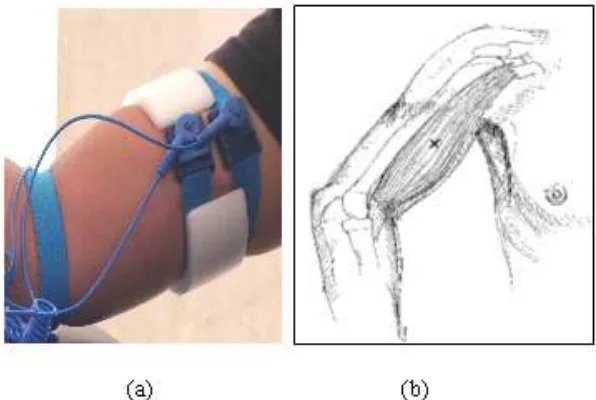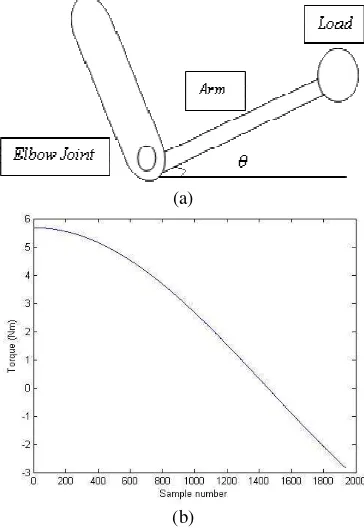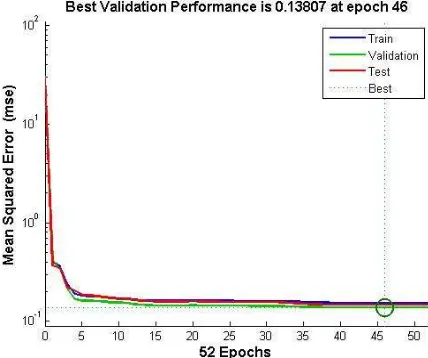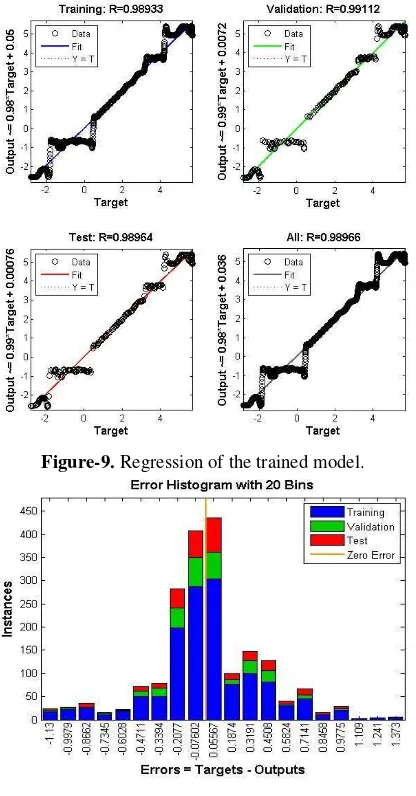1170
M. H. Jali1, T. A. Izzuddin1, Z. H. Bohari1, H. Sarkawi2, M. F. Sulaima1, M. F. Baharom1 and W. M. Bukhari1 1
Faculty of Electrical Engineering, Universiti Teknikal Malaysia Melaka, Malacca, Malaysia 2Faculty of Electronics and Computer Engineering, Universiti Teknikal Malaysia Melaka, Malacca, Malaysia
E-Mail: [email protected]
ABSTRACT
Rehabilitation device is used as an exoskeleton for peoples who had failure of their limb. Arm rehabilitation device may help the rehab program to who suffered with arm disability. The device is used to facilitate the tasks of the program and minimize the mental effort of the user. Electromyography (EMG) is the techniques to analyze the presence of electrical activity in musculoskeletal systems. The electrical activity in muscles of disable person is failed to contract the muscle for movements. To minimize the used of mental forced for disable patients, the rehabilitation device can be utilize by analyzing the surface EMG signal of normal people that can be implemented to the device. The objective of this work is to model the muscle EMG signal to torque for a motor control of the arm rehabilitation device using Artificial Neural Network (ANN) technique. The EMG signal is collected from Biceps Brachii muscles to estimate the elbow joint torque. A two layer feed-forward network is trained using Back Propagation Neural Network (BPNN) to model the EMG signal to torque value. The performance result of the network is measured based on the Mean Squared Error (MSE) of the training data and Regression (R) between the target outputs and the network outputs. The experimental results show that ANN can well represent EMG-torque relationship for arm rehabilitation device control.
Keywords: electromyography, torque, artificial neural network.
INTRODUCTION
Human support system is endoskeleton. Endoskeleton plays a role as a framework of the body which is bone. Our daily movements are fully depends on the functionality of our complex systems in the body. The disability one or more of the systems in our body will reduce our physical movements. The assistive device is a need for rehab as an exoskeleton. The functionality of the rehabilitation device has to smooth as the physical movement of normal human.
The rehabilitation programs provide the suitable program for conducting the nerve and stimulate the muscles. People who have temporary physical disability have the chances to recover. Nowadays, rehabilitation program are using exoskeleton device in their tasks. The functionality of exoskeleton depends on muscle contraction. Electromyogram studies help to facilitate the effectiveness of the rehabilitation device by analysing the signal transmitted from the muscle.
The rehabilitation device is a tool that used to help the movements for daily life activities of the patients who suffer from the failure of muscle contractions, due to the failure of the muscles contractions the movements is limited. The ability of the patients to do the tasks in the rehabilitation programs need to be measured. The rehabilitation programs have to assure whether the tasks will cause effective or bring harm to the patients [1].
Historically, the rehabilitation tasks have been avoided due to a belief that it would increase spasticity [2]. In this research, the analysis of the data will be focusing complicated process that has to be through many phases of analysis [3].
EMG signal function as a control signal for the arm rehabilitation device. A system needs a model to estimate relationship between EMG and torque [4]. EMG signal based control could increase the social acceptance of the disabled and aged people by improving their quality of life. The joint torque is estimated from EMG signals the model. Hence the EMG signals considered the ‘intent’ of the system while the joint torque is the ‘controlled’ variable for the arm rehabilitation device [7]. The network is evaluated based on the best linear regression between the actual joint torque and the estimated joint torque [4]. The experiment results shows that the model can well represent the relationship between EMG signals and elbow joint torque by producing MSE of 0.13807 and average regression of 0.999.
1171
well as the discussion of each result obtained. Finally the paper ends with conclusion and recommendations.
RELATED WORKS
There have been several studies that have applied ANN for modeling the muscle activity to joint relationship. Author [7] proposed the ANN model to measure the ankle EMG-joint torque relationship at a full range of torque under isometric, supine conditions by inserting EMG signal from 6 muscle sites into the model as in the input, while the measured torque is entered into the model as the ideal output. The learning process occur approximately 16000 iterations resulting error that is less than 6 percent.
More recent study has been conducted by author [4] to predict the elbow joint angle based on EMG signals using ANN. The three layer BPNN was constructed by using the RMS of the raw EMG signal form biceps and triceps. The result from 40 group EMG signals when subjects do bowing and extending elbow joint action reveal that the prediction output from the trained network was very close with the target angle. According to author
Studies of muscle force models have been carried out by author [8]. The model was estimated based on a rectified smoothed EMG signal using the BPANN method to predict the muscle force. The proposed model can efficiently extract muscle force features from (EMG) signals in a fast and easy method. The results showed that the regression of the ANN model exceeded 99%. However among all the previous studies related to EMG based ANN model been conducted, none of them really emphasize on the data processing phase which involve EMG data processing and desired torque determination. Therefore this paper will explain in detail this phase.
METHODS
Figure-1 shows a block diagram of our research methodology that consists of two major phases. First phase is EMG data processing and desired torque determination. Second phase is the ANN construction and testing. The data collection from the first phase is used to validate and teach the ANN algorithm in second phase.
Experimental setup
Implementation of arm rehabilitation device based on movement is recorded from the EMG signal of healthy subjects. From the human anatomy studies, different angle movements of upper limb with elbow as the reference is depends on relation of agonist and antagonist. In this study is focusing on the behaviour of biceps muscle as agonist and the triceps as the antagonist respectively. Muscle that involved in this movement is biceps and triceps, however in this study to understand the electrical activity during muscle contraction, the biceps is the only muscle that taking into account. The movements’ ranges in between position of arm flexion until arm fully extend.
The environment is in a room with low lighting especially the fluorescent light, any electromagnetic devices is away from the experiment equipment and the environment is in silent room. Then, the experimental is set up with the subject sit on the chair while the hand is on the Table. The subject has to complete the task of lift up the dumbbell with 2.268 kg of weight as shown in Figure-2(b). Normally, the appearance of EMG signal is chaos and noisy depends on the type of electrodes also the noise factor. To simplify the difference of amplitude response for the motion, the dumbbell is functioned to amplify the amplitude in analyzing the electrical activity during rest and contract. The rehabilitation devices (white in color on Figure-2(a)) helps to keep the position of the elbow joint Surface Electromyography for the Non-Invasive Assessment of Muscles (SENIAM) procedure for non-invasive methods. The subject’s skin has to be shaved by using small electrical shaver and cleaned with sterile alcohol swabs saturated with 70% Isopropyl Alcohol. This step is to be taken for minimizing the noise and to have a good contact with the electrodes of the skin by decreasing the impedance of the skin. The skin has to be clean from any contamination of body oil, body salt, hair and the dead cells. The preparation of skin can be done by wiping the alcohol swab into the area of skin that place the electrode.
1172
Figure-2. Subject is set-up with arm rehabilitation assistive device for experiment (a). Simulation of subject’s to lift up the dumbbell 5 pounds of weight (b).
The skin has to be clean from any contamination of body oil, body salt, hair and the dead cells. The preparation of skin can be done by wiping the alcohol swab into the area of skin that electrode placement to be applied. The placements of the electrode have to be at the belly of the muscles not in the tendon or motor unit. This ensured the detecting surface intersects most of the same
muscle on subject as in Figure-3(a) at the biceps brachii, and as a result, an improved superimposed signal is observed. Reference electrode has to be at the bone as the ground, for this experiment it placed at elbow joint as shown in Figure-3(b). These electrodes are connected to the combination of hardware Olimex EKG-EMG-PA and Arduino Mega for data collection.
Figure-3. The biceps brachii muscles for electrode positions (a), the electrode placements on subject skin (b).
EMG data processing
Figure-4 shows the EMG data processing block diagram. After obtained satisfactory EMG signal as shown in Figure-5(a), Fast Fourier Transform (FFT) is performed to the signal to analyses the frequency content of the signal. The EMG signal is break into its frequency component and it is presented as function of probability of their occurrence. In order to observe the variation of signal in different frequency components, the FFT signal is represented by Power Spectral Density (PSD). From the PSD we can describes how the signal energy or power is
1173
Figure-4. EMG data processing.
(a)
(b)
(c)
(d)
Figure-5.Raw EMG signal (a), Power spectral density (b),
Rectified signal(c), Smooth signal (d).
Desired torque
Desired torque of the elbow joint is used as target data for our ANN techniques as well as act as output signal for muscle [10]. The data is collected throughout the angle from 00 to 1200 angle with increment of 0.06190 each step to align with the sample number of EMG signal. Figure-6(a) shows the arm rehabilitation device position for torque calculation. The desired torque for elbow joint is determined by applying standard torque equation:
(
r
loadF
loada
armF
arm)
cos
τ
=
+
θ
(1)Where
r
loaddistance from the elbow is joint to the load,load
F
is force due to load,F
armis the force due to the massof the lever arm and
r
arm is evenly distributed distance of mass of arm distance which is half ofr
load. The angle between r and F is drawn from the same origin. A appliedload is 5 pounds (2.268kg) dumbbell and the distance from the elbow joint is 0.25m while the mass of the lever arm is 0.1kg. Figure-6(b) shows the desired torque characteristic for the elbow joint.
(a)
1174
Figure-6. Arm rehabilitation device position (a), desired torque characteristic (b).
Artificial Neural Network (ANN) Techniques
ANN is a computing paradigm that is loosely modeled after cortical structures of the brain. It consists of interconnected processing elements called nodes or neuron that work together to produce an output function. It capable to map a data set of numeric inputs with a set of numeric outputs. It is also the most widely applied training network which has input layer, hidden layer and output network layer using back propagation algorithm. An array of predetermined input is compared with the desired output response to compute the value of error function. This error is propagated back through the network in opposite direction of synaptic connections. This will adjust the synaptic weight so that the actual response value of the network moved closer to the desired response [12]. BPNN has two-layer feed-forward network with hidden neurons and linear output neurons. The function used in the hidden layer of network is sigmoid function that generates values in range of -1 to 1 [9]. There are layers of hidden processing units in between the input and output neurons. For each epoch of data presented to the neural network, the weights (connections between the neurons) and biases are updated in the connections to the output, and the learned error between the predicted and expected output, the deltas, is propagated back through the network [13].
A Lavenberg-Marquardt training back propagation algorithm is implemented for this work to model the EMG to torque signal. This algorithm is chosen due to the facts that it outperforms simple gradient descent and other conjugate gradient methods in a wide variety problem such as convergence problems. Single input EMG signal that act as a training data while single output which is the desired torque act as a target data. The network is optimized for 20 hidden neurons as shown in Figure-7[4]. The network was trained using 1839 sets of EMG data for arm flexion motion from 00 angles to 1200 angle. It also has output data which is torque of correspondent arm motion. The training process was iteratively adjusted to minimize the error and increased the rate of network performance [11]. The training has been done by dividing
the input data of 70% for training, 15% for validation and 15% for testing [8].
The performance evaluation of the network is based on the Mean Squared Error (MSE) of the training data and Regression (R) between the target outputs and the network outputs as well as the characteristics of the training, validation, and testing errors. The network is considered has the best performance if it has lowest MSE and highest R while exhibit similar error characteristics among the training, validation and testing. However even if the MSE shows very good result but the validation and testing vary greatly during the training process, the network structure is still considered unsatisfactory because the network is not generalized. Therefore further tuning and training need to be conducted in order to improve the network performance [11].
Figure-7. BPNN model
EXPERIMENTAL RESULTS
In order to optimize the network performance, different number of hidden neurons is simulated for several times until achieved the satisfactory results [11]. The network is trained using Lavemberg-Marquardt algorithm and the performance of the network is measured using MSE and R. The best validation performance of the network is 0.13807 at epoch 46 as shown in Figure-8. It is an acceptable result since the test set error and the validations set error have similar behavior. It shows that the MSE has decreased rapidly along the epochs during training. The regression also produces a good curve fitness for training, test and validation data around 0.999 which give an optimal value for our model as shown in Figure-9 [8, 14].
1175
Error sizes are well distributed since most error approaching zero values that make the trained model perform better as shown in Figure-10(a). The network has maximum instance around 450 of MSE distributed around the zero line of the error histogram [14]. Figure-10(b) shows a comparison between prediction output from the trained network and target torque. The prediction output has fairly good agreement with the characteristics of the target data.
Figure-9. Regression of the trained model.
Figure-10. Error histogram of the trained model (a), Target vs trained network output (b). CONCLUSIONS
Based on the result, it can be concluded that the ANN model with 20 hidden neurons produce MSE of 0.13807 and average regression of 0.999. It is consider a good performance as it shows that this neural network model can well represent the relationship between EMG signals and elbow joint torque. Hence this model can be used for motor torque control of the arm rehabilitation devices. The model can be further improved by applying other artificial intelligence training algorithm such as genetic algorithm and particle swarm optimization to produce better mean squared error and regression performance result.
ACKNOWLEDGEMENTS
The authors would like to thanks Universiti Teknikal Malaysia Melaka (UTeM) and Ministry of Education, Malaysia for the financial supports given through Research Grant.
REFERENCES
[1] S. D. C. G. C. Louise Ada.”Strengthening Interventions Increase Strength and Improve Activity after Stroke: A Systematic Review,” Australian Journal of Physiotherapy, vol. 52, pp. 241-248, 2006.
[2] B.B.:Adult Hemiplegia:Evaluation and treatment.Oxford, Butterworth-Heinemann., 1990.
[3] J. Muthuswamy. “Biomedical Signal Analysis in Standard Handbook Of Biomedical Engineering And Design,” Mc-Graw Hill, 2004, pp. 18.1 - 18.30.
[4] Li Dapeng, Zhang Yaxiong. “Artificial Neural Network Prediction of Angle Based on Surface Electromyography,” International Conference on Control, Automation and Systems Engineering (CASE). pp. 1-3, 2011.
1176
[6] Morita, S. Kondo, T. Ito, K. “Estimation of Forearm Movement from EMG Signal and Application to Prosthetic Hand Control,” IEEE International Conference on Robotics and Automation (ICRA).vol.4, pp. 3692-36972, 2001.
[7] Kent, L.M. Siegler, S. Guez, A. “Freedman, W. .: Modelling Of Muscle EMG to Torque by the Neural Network Model of Backpropagation,” IEEE International Conference of the Engineering in Medicine and Biology Society, Proceedings of the Twelfth Annual. pp 1477-1478, 1990.
[8] Naeem, U.J. Abdullah, A.A. “Caihua Xiong.: Estimating human arm's muscle force using Artificial Neural Network,” IEEE International Symposium on Medical Measurements and Applications Proceedings (MeMeA). pp 1-6, 2012.
[9] Favieiro, G.W. Balbinot, A. Barreto, M.M.G. “Decoding Arm Movements by Myoeletric Signals and Artificial Neural Networks,” Conference of Biosignals and Biorobotics (BRC). pp 1-6, 2011.
[10]M. H. Jali, M. F. Sulaima, T. A. Izzuddin, W. M. Bukhari, M. F. Baharom. “Comparative Study of EMG based Joint Torque Estimation ANN Models for Arm Rehabilitation Device,” International Journal of Applied Engineering Research (IJAER), vol. 9, Number 10 (2014), pp. 1289-1301.
[11]Ahsan, M.R.; Ibrahimy, M.I.; Khalifa, O.O. “EMG Motion Pattern Classification through Design and Optimization of Neural Network,” International Conference on Biomedical Engineering (ICoBE). pp 175-179, 2012.
[12]B. Hudgins, P. Parker, and R. Scott.”A new strategy for multifunction myoelectric control,” IEEE Trans. Biomed. Eng., vol. 40, no. 1, pp. 82-94, January. 1993.
[13]Mars, P, Chen JR, Nambiar, R “Learning Algorithms: Theory and applications in signal processing, control and communications,” CRC 1996.




